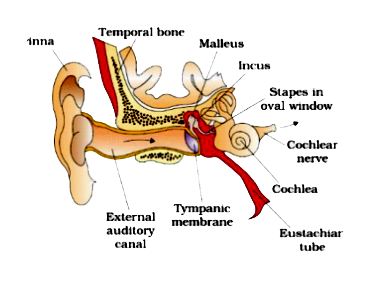Briefly describe the structure of the following :
(a) Brain
(b) Eye
(c) Ear
Video Solution
Text Solution
(a) Brain
Brain is the main coordinating centre of the body. It is a part of nervous system that controls and monitors every organ of the body. It is well protected by cranial menings that are made up of an outer layer called dura mater, a thin middle layer called arachnoid, and an inner layer called pia mater.
It is dividend into three regions - forebrain, midbrain, and hindbrain.
Forebrain
It is the main thinking part of the brain. It consists of cerebrum, thalamus and hypothalamus.
Cerebrum : Cerebrum is the largest part of the brain nd consitutes about four-fifth its weight. These hemispheres are joined by a tract of nerve fibre known as corpus callosum. The cerebral hemispheres are covered by a layer of cells known as cerebral cortex or grey matter. Cerebrum has sensory rigions known as association areas that receive sensory impulses from various muscles. The innermost part of cerebrum gives an opaque white appearance to the layer and is known as the white matter.
Thalamus : Thalamus is the main centre of coordination for sensory and motor signalling. It is wrapped by cerebrum.
Hypothalamus : It lies at the base of thalamus and contians a number of centres that regulate body temperaure and the urge for eating and drinking. Some regions of cerebrum, along with hypothalamus, are involved in the regulation of sexual behaviour and expression of emotional reactions such as excitement, pleasure, fear, etc.
Midbrain
It is located between tha thalamus region of the forebrain and pons region of hindbrain. The dorsal surface of midbrain consists of superior and inferior corpora bigemina and four round lobes called corpora quadrigemina.
A canal known as cerebral aqueduct passes through the midbrain. Midbrain is concerned with the sense of sight and hearing.
Hindbrain
It consists of three regions - pons, cerebellum, and medulla oblongta.
Pons : Pons is a band of nerve fibre that lies between medulla oblongta and midbrain. It connects the lateral parts of cerebellar hemisphere together.
Cerebellum : Cerebellum is a large and well developed part of hindbrain. Which is located below the posterior sides of cerebral hemispheres and above medulla oblongata. It is responsible for maintianing posture and equilibrium of the body.
Medulla Oblongata : Medulla oblongta is the posterior and simplest part of the brain. Which is located beneath the cerebellum. Its lower and extends in the form of spinal cord and leaves the skull through foraman magnum.

(b) Eye
Eyes are spherical structures that consists of three layers.
(i) The outer layer is composed of sclera and cornea.
Sclera is an opaque tissue that is usually known as white of the eye. Which is composed of a dense connective tissue.
Cornea is a transparent anterior portion of eye that lacks blood vessels and is nourished by lymph from the nearby area. It is slightly bulged forward and helps in focusing light rays with the help of lens.
(ii) The middle layer of eye is vascular in nature and contains choroid, ciliary body and iris.
Choroid : It lies next to the sclera and contains numerous blood vessels that provide nutrients and oxygen to the retina and other tissues.
Ciliary body : The choroid layer is thin over posterior region and gets thickened in the anterior portion to form ciliary body. It contains blood vessels, ciliary muscles, and ciliary processes.
Iris : At the junction of sclera and cornea, the ciliary body continues forward to form thin coloured partition called iris. It is the visible coloured portion of eye.

(c) Ear
Ear is the sense organ for hearing and equilibrium. It consists of 3 portions - external ear, middle ear, and internal ear.
External Ear
It consists of pinna, external auditory meatus, and a tympanic membrane.
Pinna is a sensitive structure that collects and directs the vibrations into the ear to produce sound.
External auditory meatus is a tubular passage supported by cartilage in external ear.
Tympanic membrane is a thin membrane that lies close to the auditory canal. It separates the middle ear from external ear.
Middle Ear
It is an air - filled tympanic cavity that is connected with pharynx through eustachian tube. Eustachian tube helps to equilizer air pressure in both sides of tympanic membrane. The middle ear contains a flexible chain of three middle bones called ear ossicles. The 3 ear ossicles are malleus, incus , and stapes that are attached to each other.
Internal Ear
It is also known as labyrinth . Labyrinth is dividend into bony labyrinth and a membranous labyrinth. Bony labyrinth is filled with parilymph while membranous labyrinth is filled with a endolymph. Membranous labyrinth is dividend into 2 parts.
Vestibular Apparatus : Vestibular apparatus is central sc-like part that is divident into utriculus. Vestibular apparatus also contains a projecting ridge called crista ampularis. Each ampulla has a group of sensory cells called crista. Crista and macula are responsible for maintaining the balance of body and posture occurs,
Cochlea : Cochlea is a long and coiled outgrowth of sacculus. It is the main hearing organ. Cochlea consists of three membranes. The organ of corti, a hearing organ, is located on the basiclar membrane that has hair cells.
|
Updated on:21/07/2023
Topper's Solved these Questions
Similar Questions
Briefly describe the structure of the neuron.
View SolutionBriefly describe the cell theory.
View SolutionBriefly describe the structure and functions of cell wall.
View SolutionBriefly describe Baudhnath Stupa?
View SolutionBriefly describe Baudhnath Stupa?
View SolutionDraw labelled diagrams of the following :
(a) Neuron
(b) Brain
(c) Eye
(d) EarView SolutionBriefly describe the bioinformatics
View SolutionBriefly describe the tropical forest biomes.
View SolutionBriefly describe the term given below:
CokeView SolutionBriefly describe the structure of ear with the help of a suitable diagram.
View Solution

